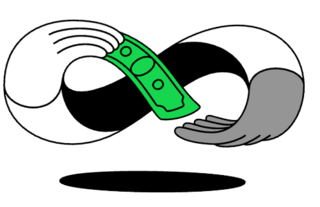From Virtual Tip Jars to Travel Budgets, Here’s How Real People Use Money Transfer Apps

Money transfer apps have come a long way since the days of shooting a few bucks between friends.
Over the last few years, Cash App, Venmo and Paypal have morphed into all-in-one financial toolkits, where users can file their taxes and dabble in crypto as easily as they can tip their tattoo artist and split rent with their roommates.
In many ways, these platforms have shifted how we connect with one another — creating new norms around everything from gift-giving to happy hour bills. And while the popular payments network Zelle recently shuttered its mobile app, its competitors in the digital payment space continue to shape the way we manage, save and share money. Let’s take a closer look.
Tap to shop
Millions of brick-and-mortar businesses now accept payment apps for in-store purchases, with the help of QR codes, “tap to pay” mobile apps and point of sale (POS) systems that let shoppers breeze through the checkout line.
At mall staples like Foot Locker and Forever21 — two of the growing number of retailers that let customers pay with the Venmo app or the app of its parent company Paypal — the apps reduce operational costs and inefficiencies in checkout lines and help build stronger connections with young, digitally-native shoppers.
For small business owners, freelancers and gig workers, they enable operational flexibility, clear-cut expense tracking and the ability to receive payments (and tips) from an increasingly cash-free customer base.
Power in numbers
Coordinating group gifts, events and other shared expenses has also become more manageable with the widespread adoption of money transfer apps.
PayPal, for one, lets users create “pools,” or shared collection funds, that family and friends can contribute to. Venmo Groups, an in-app feature that debuted in 2023, provides a straightforward solution for splitting bills between friends planning a group vacation, an office potluck or any other shared activity.
Next-gen finance
Cash App, Venmo and PayPal users can now buy, sell and hold crypto through a spectrum of features tailored to a broad audience.
At Cash App, users who sign up for a debit card can “round up” every transaction to the nearest dollar, and invest the spare change in stocks, ETFs or bitcoin — an easy access point for people who want to dip their toes into investing without making a major commitment. (They can also opt to put their spare change into a high-interest savings balance instead.) Users with more experience can choose to have their paychecks directly deposited into bitcoin, too.
Tips to make the most out of money transfer apps:
Know the fees: It’s important to understand the cost of using money transfer apps so you can dodge unnecessary fees. Not all transactions are free, especially if you’re sending money with a credit card or opting for an instant bank transfer. Take a minute to review the fine print, it could save you a few bucks.
Double-check recipient details: Transfer reversals can be difficult if sent to the wrong recipient. Double-check the username, email, or phone number so your money reaches the person it's supposed to.
Link to the right account: Connect to a bank account you frequently use (and regularly check) to help keep tabs on your spending and avoid overdraft fees.
Don’t skimp on security: These accounts handle your money, so don’t skip security features like two-factor authentication.
Don’t treat a positive balance like a savings account: Avoid letting funds linger in your account. Regularly transfer any positive balance to a high-yield savings account, either at an external bank or within the app.
More from Money
Money Transfer Apps: A Comprehensive Guide





